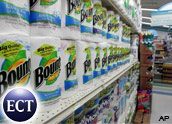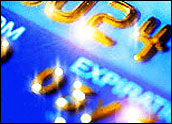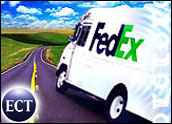
“Smart” shopping carts have been around for a while, but until recently, they haven’t managed to gain much traction.
Now, some momentum is building, according to proponents of the computer-rigged market baskets that — with a swipe of a card — can flash an alert that a customer’s favorite brand of ice cream is on sale, display nutritional values of products, and even point out the aisles where items are located.
Wireless touchscreens also can compile shopping lists based on a customer’s own history or provide insight into an individual’s caloric intake, based on purchases over periods of weeks or even months.
Quincy, Mass.-based Modiv Media markets gadgetry that some might think would be more at home in an electronics store than in a supermarket.
Through partnerships with such technology giants as Fujitsu and Motorola, the company is bringing mobile data systems to grocery aisles.
In January, Modiv Media and Motorola’s enterprise mobility business introduced the Modiv Shopper, a handheld data device powered by a Motorola MC17 computer, into 100 Stop & Shop Supermarkets in the Northeast.
The device, known as “easySHOP,” lets customers opt for “scan-and-bag” service, speedy self-checkout, instant price checks and running totals.
Customers also get information on promotions tailored to their individual shopping history, coupon-redemption history and other personalized criteria.
Easy Out
Stop & Shop has a history with high-tech shopping tools, having begun their experiments with smart carts years ago.
In 2005, the grocery chain tested the Shopping Buddy, for example, a cart-mounted kiosk that let customers scan a card on the cart to automatically download their information. It let them place an order with the deli, flashed alerts on relevant specials, and served as a guide to item locations.
Stores that use high-tech shopping tools are providing what a growing number of consumers want: a way to get in and out of the store quicker, Paul Schaut, CEO of Modiv Media, told CRM Buyer.
“They’re giving them unique offers they wouldn’t have had otherwise,” he said, “so, the consumer is smiling as they’re getting out, because they’re redeeming an average of two offers per trip.”
Retailers benefit from increased sales, Schaut added.
“The retailer is increasing their lift — their basket size,” he said. “The consumer [is] now buying more … because they’re getting relevant offers that encourage them to buy what they might not have bought otherwise.”
There’s a reason most retailers don’t bother with such high-tech gadgets, however, Forrester analyst Vidya Drego told CRM Buyer.
“I’ve seen this technology come up in the past; I don’t know whether it was the technology or usability, but it drove [customers] out of the stores,” Drego said.
The idea of programming a shopping trip can be intimidating, Drego said.
“Things like this need to be extremely easy to use,” she emphasized. For the average shopper, mastering such technology won’t be worth the effort.
“The consumer says, ‘I’m here to shop. This is too overwhelming,'” said Drego.
However, Modiv Media has recognized that drawback and worked on it, said Schaut.
“We dummied it down to make it easier to save time,” he said. “It was too complex before — too powerful. Therefore, it was not adopted.”
There are other ways to turn high-tech tricks loose in the grocery store, whether through digital TV screens or other gadgetry, Drego noted.
Safeway Goes Its Own Way
Indeed, Pleasanton, Calif.-based Safeway, while bypassing ideas like smart carts, has its own data streams designed to help consumers.
The chain’s FoodFlex program, launched this year, focuses on wellness, company spokesperson Teena Massingill told CRM Buyer.
“We do have in some stores — kind of in the area of natural foods — some TV screens that talk about eating properly and things like that,” Massingill said. “There are some mommy tips — but that’s just hit or miss, and not in many stores.”
FoodFlex, an offshoot of the chain’s Club Card program, tracks purchases of registered members, Massingill said.
“You can get an overall snapshot, and it will tell you if you’re high or low on specific nutritional attributes,” she explained. “For instance, it will tell you if it looks like you’re consuming too much sodium.”
The “snapshot” can capture a single purchase or a month’s worth.
“You can drill down to figure out what you’ve purchased,” said Massingill. “If you’re looking for cereal that’s low in sugar and high in fiber, it will help you find that. With FoodFlex, initially when you sign up, you provide certain information about your family. How many people matters in calculating what you’re buying.”
Technology will continue to reach into the aisles of more grocery stores, Schaut predicted.
“The first challenge was crossing the chasm, getting over the big hurdle of having one retailer spend millions of dollars in putting it into hundreds of stores,” he said. “Seeing that the benefits are real, they’re now expanding the program, and Stop & Shop will roll it out to more stores.”
By next year, Modiv Media gadgetry will be in 500 to 1,000 supermarkets.
“That’s the point of critical mass,” Schaut said. “Riding the coattails of other major companies that have self-service systems is a way to accelerate the rollout.”
















































